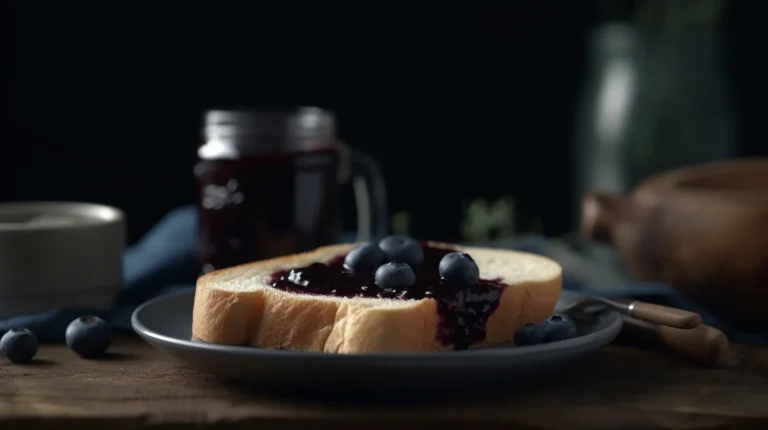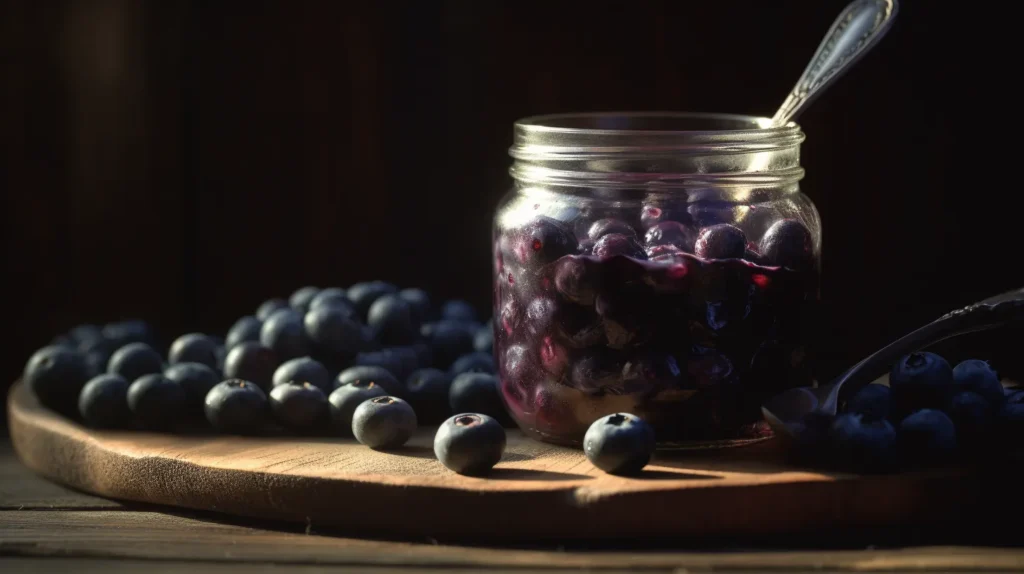
When choosing between blueberry compote vs jam, it’s essential to understand their key differences in texture, ingredients, preparation, and best uses. While both are delicious blueberry-based spreads, they serve different culinary purposes.
Blueberry compote is a chunky, syrupy fruit topping, while blueberry jam is thicker, spreadable, and preserved for longer storage. If you’ve ever wondered which one to use for breakfast, desserts, or baking, this guide will break down everything you need to know.
By the end of this article, you’ll be able to choose the best option for your recipes, understand how to make each one, and learn about their nutritional differences and storage methods.
Let’s dive into the five major differences between blueberry compote and jam!
Table of Contents
What Is Blueberry Compote vs Jam?
Before comparing them, let’s define what blueberry compote vs jam actually means.
What Is Blueberry Compote?

Blueberry compote is a simple fruit sauce made by lightly cooking whole blueberries with sugar and sometimes lemon juice or spices. Unlike jam, compote doesn’t require pectin or long cooking times.
✅ Key Features of Blueberry Compote:
- Chunky texture with whole or lightly mashed blueberries.
- Quick and easy preparation (cooks in 10-15 minutes).
- Not shelf-stable, must be stored in the fridge.
- Used as a topping for pancakes, waffles, yogurt, or desserts.
What Is Blueberry Jam?
Blueberry jam is a thicker fruit spread made by cooking mashed blueberries with sugar and pectin until it reaches a gel-like consistency.
✅ Key Features of Blueberry Jam:
- Smooth, spreadable texture due to longer cooking time.
- Pectin is often used to help it set properly.
- Longer shelf life and can be canned for months.
- Commonly used on toast, pastries, and in baking.
The Serious Eats guide on fruit spreads explains that jams require higher sugar content and longer cooking times than compotes, which helps preserve them for months or even years when properly stored.
1. Ingredients & Sweetness Levels
The ingredients used in blueberry compote vs jam create major differences in flavor, texture, and storage ability.
Blueberry Compote Ingredients:
- Blueberries (fresh or frozen)
- Sugar or natural sweeteners (honey, maple syrup)
- Lemon juice (enhances flavor and prevents browning)
- Optional spices (cinnamon, vanilla, nutmeg)
Compote contains less sugar than jam, making it a healthier, lower-calorie option.
Blueberry Jam Ingredients:
- Blueberries (mashed or blended)
- More sugar than compote (acts as a preservative)
- Pectin (to help it set and thicken)
- Lemon juice (activates pectin and balances sweetness)
Since jam is meant for long-term storage, it requires more sugar and pectin to achieve a spreadable consistency.
2. Texture & Consistency
The biggest difference between blueberry compote vs jam is their texture.
Blueberry Compote Texture:
- Soft and syrupy with visible chunks of fruit.
- Lighter and more fluid than jam.
- Can be easily poured or spooned over foods.
Blueberry Jam Texture:
- Thick, gel-like consistency due to pectin.
- Holds its shape when spread on toast or pastries.
- Requires longer cooking time for a firmer set.
If you want a spreadable fruit preserve, jam is the better choice. But if you prefer a chunky, fruit-forward topping, compote is the way to go.
3. Cooking Process & Preparation Time
Another major difference between blueberry compote vs jam is how they’re made.
How to Make Blueberry Compote:
- Combine blueberries, sugar, and lemon juice in a saucepan.
- Cook over medium heat for 10-15 minutes, stirring occasionally.
- Let cool and use immediately, or store in the fridge.
👉 Total time: 10-15 minutes
How to Make Blueberry Jam:
- Mash blueberries and sugar in a pot over medium heat.
- Add pectin and lemon juice, stirring constantly.
- Boil for 30-45 minutes until thickened.
- Pour into sterilized jars and process for canning.
👉 Total time: 30-45 minutes
Because jam needs pectin to set, it takes longer to cook than compote.
4. Storage & Shelf Life
Since blueberry compote vs jam have different sugar levels and preparation methods, they also vary in storage time.
Blueberry Compote Storage:
- Refrigerator: 5-7 days in an airtight container.
- Freezer: Up to 3 months.
Blueberry Jam Storage:
- Pantry: 6-12 months if canned properly.
- Refrigerator: 2-3 weeks after opening.
- Freezer Jam: Up to 1 year.
Since jam contains more sugar and pectin, it lasts much longer than compote.
5. Best Uses for Blueberry Compote vs Jam
Now that you know their differences, when should you use each one?
Best Ways to Use Blueberry Compote:
✅ Topping for pancakes, waffles, or French toast.
✅ Swirled into yogurt, oatmeal, or smoothie bowls.
✅ Drizzled over cheesecake, ice cream, or pound cake.
✅ Mixed into savory dishes like meats and cheese boards.
👉 Try this homemade blueberry compote recipe!
Best Ways to Use Blueberry Jam:
✅ Spread on toast, bagels, or English muffins.
✅ Used as a filling for pastries, cookies, and tarts.
✅ Stirred into salad dressings, marinades, or glazes.
✅ Mixed into baking recipes like muffins and cakes.
For more blueberry recipes, check out what makes a compote?.

FAQs About Blueberry Compote vs Jam
Can You Substitute Jam for Compote?
Yes, you can substitute blueberry jam for blueberry compote in many recipes, but there are some key differences to consider. Since jam is thicker and contains more sugar, it may not work as a perfect one-to-one substitute in all cases.
How to Adjust Jam for a Compote-Like Consistency:
✅ Thin it out – Add a small amount of water, fruit juice, or lemon juice to loosen the consistency. Start with 1-2 tablespoons per ½ cup of jam and adjust as needed.
✅ Warm it up – Heat the jam on low until it softens, making it easier to drizzle over pancakes, waffles, or desserts.
✅ Adjust sweetness – Since jam is much sweeter, you may want to balance the flavor by adding a bit of lemon juice or a pinch of salt.
💡 Best Uses for Substituting Jam for Compote:
- As a pancake or waffle topping (thinned out).
- Stirred into yogurt or oatmeal.
- As a filling for desserts like cheesecakes or pastries.
However, if a recipe relies on the chunkiness and fresh fruit flavor of compote, using jam may alter the texture and sweetness too much.
Which Is Healthier, Compote or Jam?
Generally, blueberry compote is the healthier option because it contains less sugar and more whole fruit.
Why Is Compote Considered Healthier?
✅ Lower in sugar – Since compote doesn’t require large amounts of sugar for preservation, it retains more natural fruit flavor without excess sweetness.
✅ More whole fruit & fiber – Compote is made with whole or lightly mashed blueberries, which means it contains more fiber and nutrients compared to jam.
✅ Less processing – Because compote cooks for a shorter time, it retains more antioxidants, vitamins, and minerals found in fresh blueberries.
Why Does Jam Have More Sugar?
- Jam requires more sugar to help preserve it for long-term storage.
- Sugar also helps activate pectin, which thickens jam.
- Store-bought jams often contain additional preservatives and stabilizers.
💡 Health Tip: If you prefer jam but want to reduce sugar, look for low-sugar or fruit-sweetened jam options, or make your own homemade blueberry jam with natural sweeteners.
Does Blueberry Compote Need Pectin?
No! Blueberry compote does not require pectin because it naturally thickens as it reduces during cooking.
Why Doesn’t Compote Need Pectin?
✅ Blueberries contain natural pectin, so cooking them slightly thickens the mixture on its own.
✅ Shorter cooking time prevents the need for extra thickeners.
✅ Compote is meant to be looser and syrupy, rather than thick like jam.
When Might You Want to Thicken Compote?
If you prefer a slightly thicker compote, you can:
- Simmer it a few extra minutes to let more liquid evaporate.
- Add a teaspoon of cornstarch mixed with water or lemon juice.
- Use chia seeds, which naturally absorb liquid and create a thicker texture.
💡 Pro Tip: If you want a chunky, fresh-tasting fruit topping, stick with traditional compote without added thickeners!
Can You Can Blueberry Compote?
No, blueberry compote is not shelf-stable like jam and should not be canned for long-term storage. However, you can freeze it for later use.
Why Can’t Compote Be Canned?
❌ Lower sugar content – Unlike jam, compote doesn’t have enough sugar to act as a preservative.
❌ Shorter cooking time – Compote is only lightly cooked, which doesn’t kill bacteria for long-term storage.
❌ Lack of pectin – Since it’s not designed to set like jam, it lacks the proper consistency for canning.
Best Way to Store Blueberry Compote:
✅ Refrigerator: Store in an airtight container for up to 7 days.
✅ Freezer: Store in freezer-safe jars or silicone molds for up to 3 months.
How to Freeze & Reheat Compote:
1️⃣ Let the compote cool completely.
2️⃣ Pour into small airtight containers or freeze in ice cube trays for easy portioning.
3️⃣ To thaw, place in the fridge overnight or warm gently on the stove before serving.
💡 Pro Tip: If you love the convenience of jam but prefer the fresh taste of compote, make a big batch and freeze it in portions for quick use!
Final Thoughts on Blueberry Compote vs. Jam Substitutions & Storage
- Substituting jam for compote can work, but you may need to adjust the texture and sweetness.
- Compote is healthier due to less sugar and more whole fruit.
- Compote doesn’t need pectin, while jam relies on it for thickening.
- Compote cannot be canned, but it freezes well for up to 3 months.
Now that you know the best ways to use and store blueberry compote vs jam, you can choose the right one for your recipes and enjoy their unique flavors and textures!
Looking for a delicious blueberry compote recipe? Try this homemade blueberry compote guide to make your own in just minutes! 😊💙
Conclusion: Which One Should You Choose?
Now that we’ve explored blueberry compote vs jam in detail, it’s time to answer the big question: Which one is better? The truth is, it depends on your needs and preferences.
Choose Blueberry Compote If:
✔️ You prefer a fresh, fruit-forward topping with less sugar.
✔️ You want a quick and easy recipe that takes under 15 minutes to prepare.
✔️ You love chunky textures with whole blueberries intact.
✔️ You enjoy versatile toppings for pancakes, waffles, yogurt, oatmeal, and desserts.
✔️ You’re looking for a lighter, healthier alternative without the need for preservatives.
Compote is ideal for those who love simple, homemade fruit sauces that bring out the natural sweetness and texture of fresh blueberries. However, since it doesn’t contain preservatives or pectin, it must be refrigerated and consumed within a few days or frozen for later use.
Choose Blueberry Jam If:
✔️ You need a thicker, spreadable fruit preserve that holds its shape.
✔️ You want something longer-lasting that can be canned and stored for months.
✔️ You love smooth fruit spreads for toast, bagels, muffins, and pastries.
✔️ You prefer a classic, sweet blueberry flavor that’s more concentrated.
✔️ You enjoy using jams in baking recipes, salad dressings, or glazes for meats.
Jam is a great choice for preserving fruit long-term and creating a versatile pantry staple. It requires more sugar and pectin, but it delivers a firmer, richer consistency that’s ideal for spreading and baking.
Final Thoughts: Use Both for Different Purposes!
The good news? You don’t have to choose just one! Both blueberry compote and jam have their own benefits, and each can enhance different types of dishes.
💡 Try This Approach:
- Make blueberry compote when you want a fresh, fruity sauce for breakfast and desserts.
- Use blueberry jam when you need a long-lasting, spreadable option for breads and baking.
Now that you understand the differences, you can use them more effectively in your recipes and enjoy the best of both worlds!
Looking for more blueberry-based recipes? Check out what makes a compote? for additional inspiration. Happy cooking! 😊🍇
